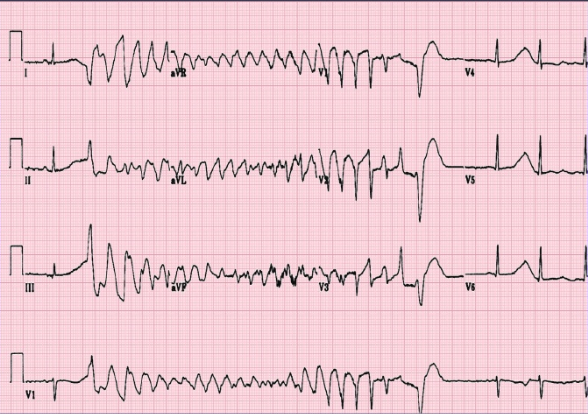Brugada syndrome natural history, complications and prognosis
|
Brugada syndrome Microchapters |
|
Diagnosis |
|---|
|
Treatment |
|
Case Studies |
|
Brugada syndrome natural history, complications and prognosis On the Web |
|
American Roentgen Ray Society Images of Brugada syndrome natural history, complications and prognosis |
|
FDA on Brugada syndrome natural history, complications and prognosis |
|
CDC on Brugada syndrome natural history, complications and prognosis |
|
Brugada syndrome natural history, complications and prognosis in the news |
|
Blogs on Brugada syndrome natural history, complications and prognosis |
|
Risk calculators and risk factors for Brugada syndrome natural history, complications and prognosis |
Editor-In-Chief: C. Michael Gibson, M.S., M.D. [1] Associate Editor(s)-in-Chief: Sogand Goudarzi, MD [2]
Overview
Brugada syndrome usually becomes apparent in adulthood, although it may present in infants and children as sudden cardiac death. The mean age of sudden death in patients with Brugada syndrome is 40 years old. The Brugada patient may develop atrial arrhythmias and abnormalities in atrial conduction, and these abnormalities are associated with inducibility of ventricular fibrillation. Implantation of a cardiac defibrillator AICD can improve prognosis for some.
Natural History
Brugada syndrome usually becomes apparent in adulthood, although signs and symptoms, including sudden death, can occur any time from early infancy to old age. The mean age of sudden death is approximately 40 years. This condition may explain some cases of sudden infant death syndrome (SIDS), which is a major cause of death in babies younger than one year. It is characterized by sudden and unexplained death, usually during sleep. Sudden unexplained nocturnal death syndrome (SUNDS) is a condition characterized by unexpected cardiac arrest in young adults, usually at night during sleep. This condition was originally described in Southeast Asian populations, where it is a major cause of death. Researchers have determined that SUNDS and Brugada syndrome are the same disorder.
Patients with Brugada syndrome frequently develop or are born with supraventricular tachycardias:[1]
- Supraventricular tachycardia: 20% of Brugada patients
- Atrial fibrillation: 10% - 20% of Brugada patients
- Atrioventricular (AV) nodal reentrant tachycardia
- Wolff-Parkinson-White syndrome[2]
Disturbances of atrial conduction and sinus node function have also been reported:
- Prolonged sinus node recovery time and sinoatrial conduction time [3]
- Slowed atrial conduction[4]
- Atrial standstill[4]
The appearance of atrial arrhythmias and impaired atrial conduction are remarkable in so far as these findings are associated with inducibility of ventricular fibrillation.[5] Indeed those patients who undergo implantation of a defibrillator (AICD) have twice the incidence of atrial arrhythmias (27% versus 13%)(p<0.05).
Complications
The following arrhythmias may occur in the patient with Brugada syndrome:
- Polymorphic VT resembling a rapid Torsade de Pointes (TdP) as shown below:

- Common complications of Brugada syndrome include:
- Monomorphic VT is observed infrequently
- VT/VF often terminates spontaneously in patients with the Brugada syndrome which may explain why patients wake up at night after episodes of agonal respiration caused by the arrhythmia.[6]
Prognosis
- Patients who are symptomatic with unexplained syncope, ventricular tachycardia or aborted sudden cardiac death may have a symptom recurrence risk of 2% to 10% per year. In these patients an AICD implant is advisable.[7]
References
- ↑ Morita H, Kusano-Fukushima K, Nagase S, Fujimoto Y, Hisamatsu K, Fujio H, Haraoka K, Kobayashi M, Morita ST, Nakamura K, Emori T, Matsubara H, Hina K, Kita T, Fukatani M, Ohe T. Atrial fibrillation and atrial vulnerability in patients with Brugada syndrome. J Am Coll Cardiol. 2002; 40: 1437–1444.
- ↑ Eckardt L, Kirchhof P, Johna R, Haverkamp W, Breithardt G, Borggrefe M (2001). "Wolff-Parkinson-White syndrome associated with Brugada syndrome". Pacing and Clinical Electrophysiology : PACE. 24 (9 Pt 1): 1423–4. PMID 11584469. Unknown parameter
|month=ignored (help);|access-date=requires|url=(help) - ↑ Morita H, Fukushima-Kusano K, Nagase S, Miyaji K, Hiramatsu S, Banba K, Nishii N, Watanabe A, Kakishita M, Takenaka-Morita S, Nakamura K, Saito H, Emori T, Ohe T (2004). "Sinus node function in patients with Brugada-type ECG". Circulation Journal : Official Journal of the Japanese Circulation Society. 68 (5): 473–6. PMID 15118291. Retrieved 2012-10-13. Unknown parameter
|month=ignored (help) - ↑ 4.0 4.1 Takehara N, Makita N, Kawabe J, Sato N, Kawamura Y, Kitabatake A, Kikuchi K (2004). "A cardiac sodium channel mutation identified in Brugada syndrome associated with atrial standstill". Journal of Internal Medicine. 255 (1): 137–42. PMID 14687250. Retrieved 2012-10-13. Unknown parameter
|month=ignored (help) - ↑ Eur Heart J (2004) 25;(10): 879-884. doi: 10.1016/j.ehj.2004.01.004
- ↑ Koene RJ, Adkisson WO, Benditt DG (December 2017). "Syncope and the risk of sudden cardiac death: Evaluation, management, and prevention". J Arrhythm. 33 (6): 533–544. doi:10.1016/j.joa.2017.07.005. PMC 5728985. PMID 29255498.
- ↑ Koene, Ryan J.; Adkisson, Wayne O.; Benditt, David G. (2017). "Syncope and the risk of sudden cardiac death: Evaluation, management, and prevention". Journal of Arrhythmia. 33 (6): 533–544. doi:10.1016/j.joa.2017.07.005. ISSN 1880-4276.